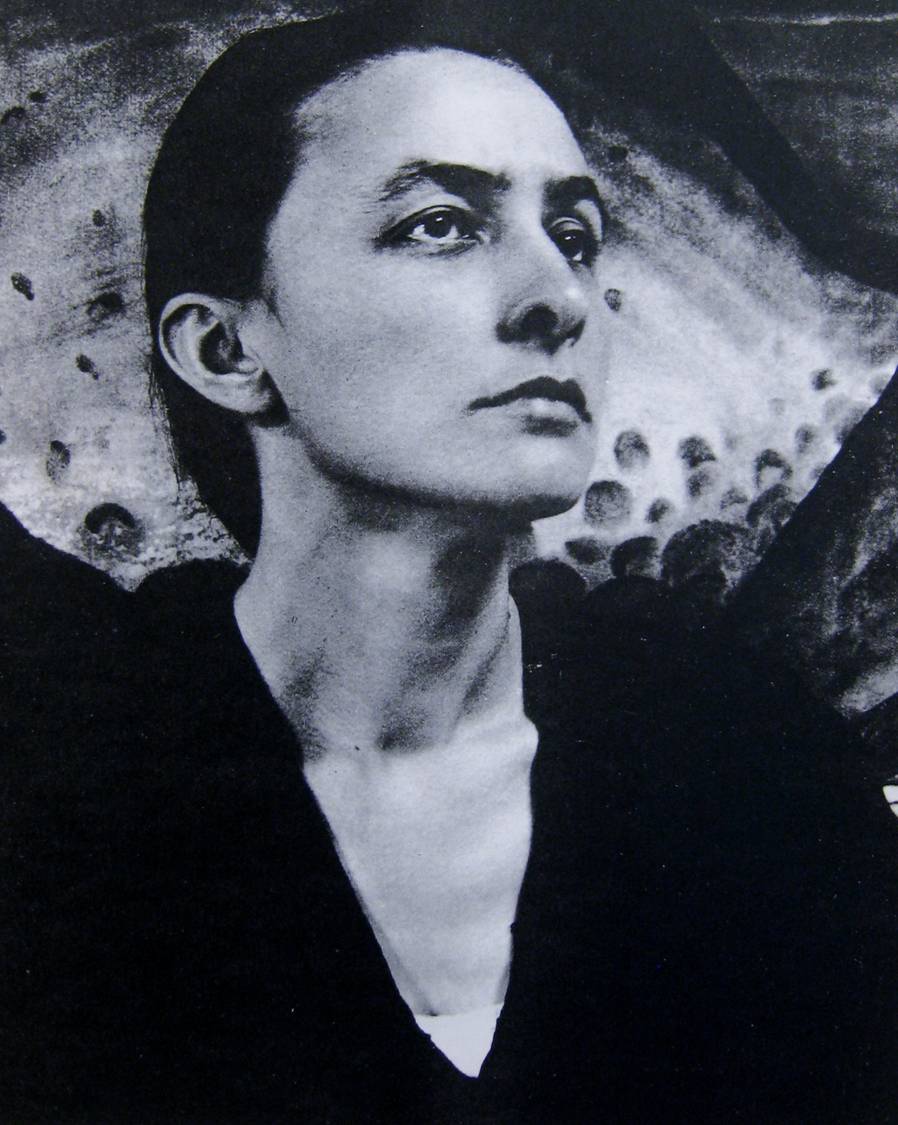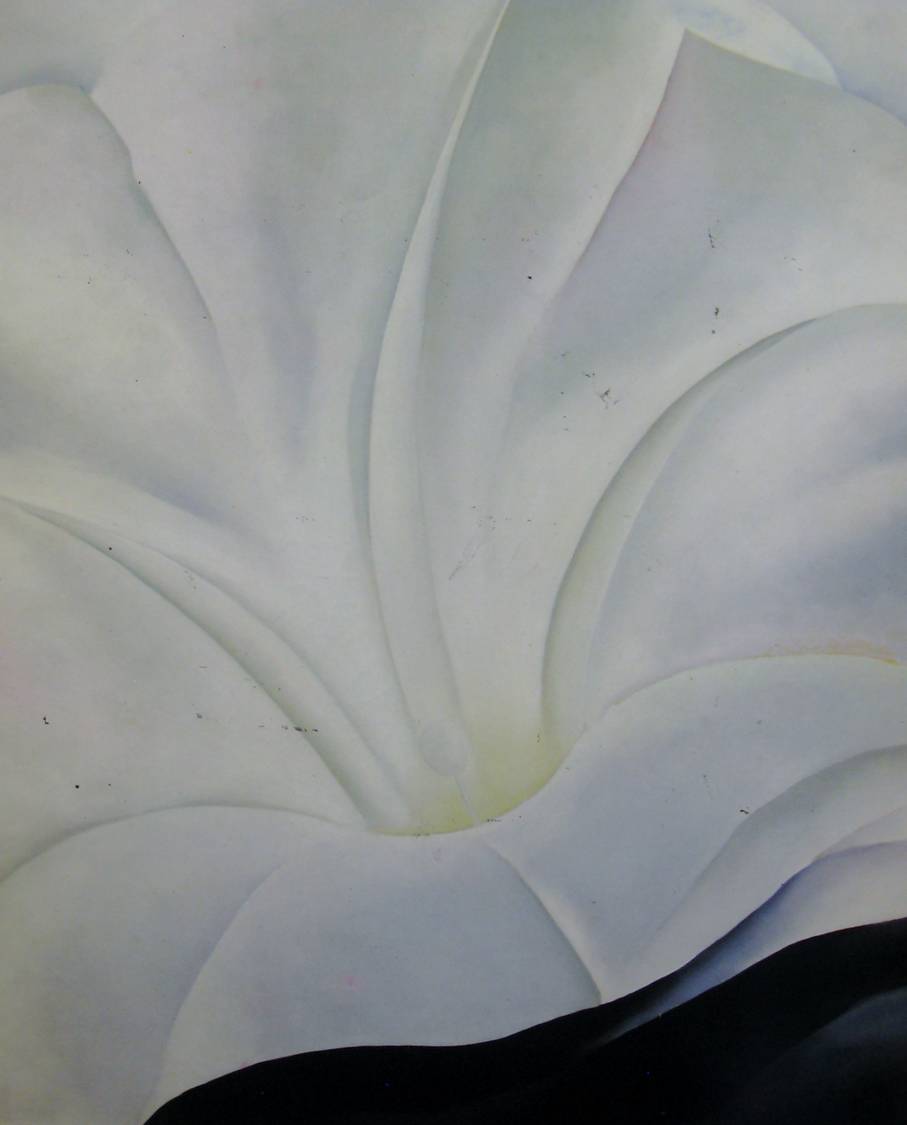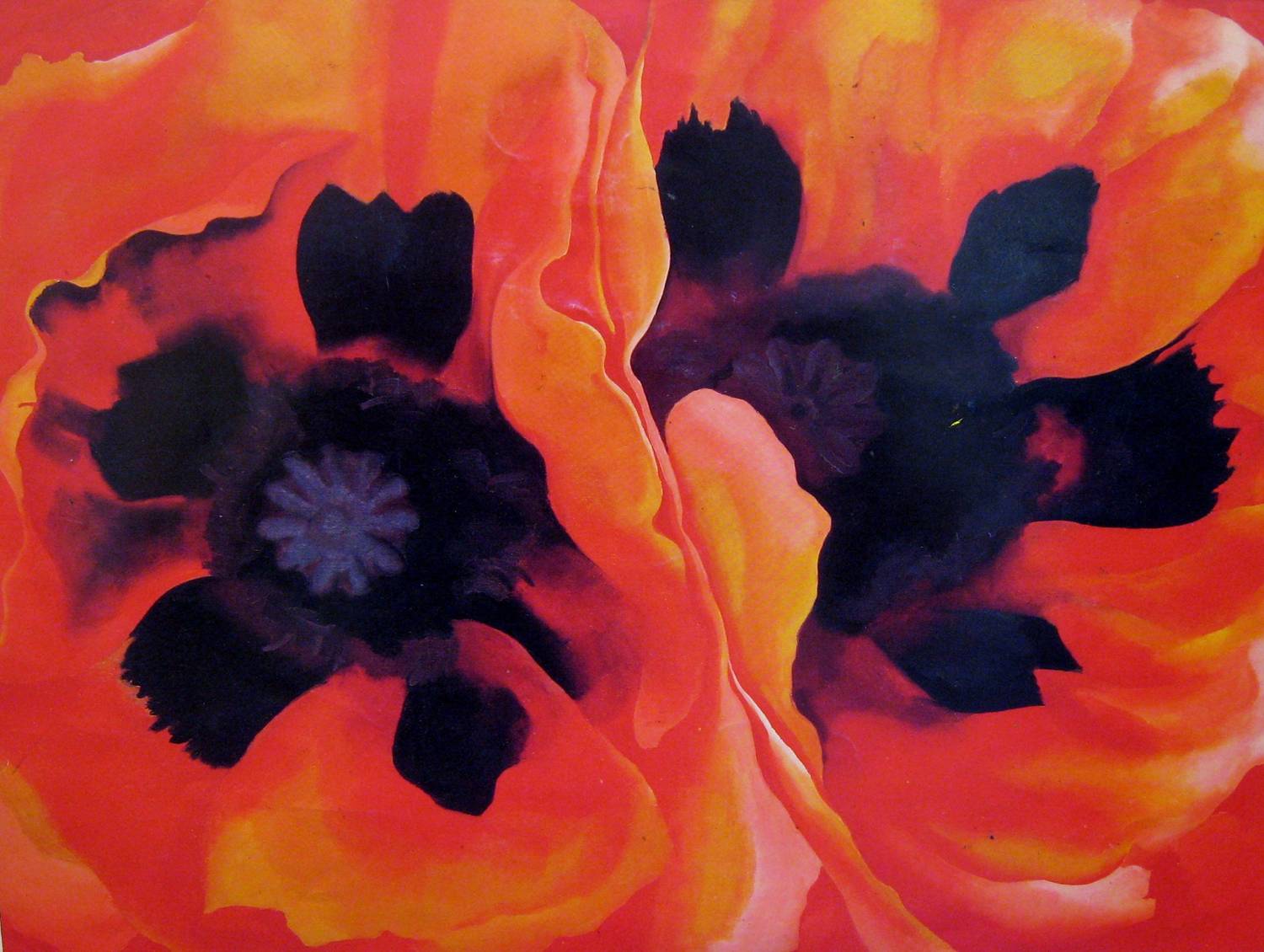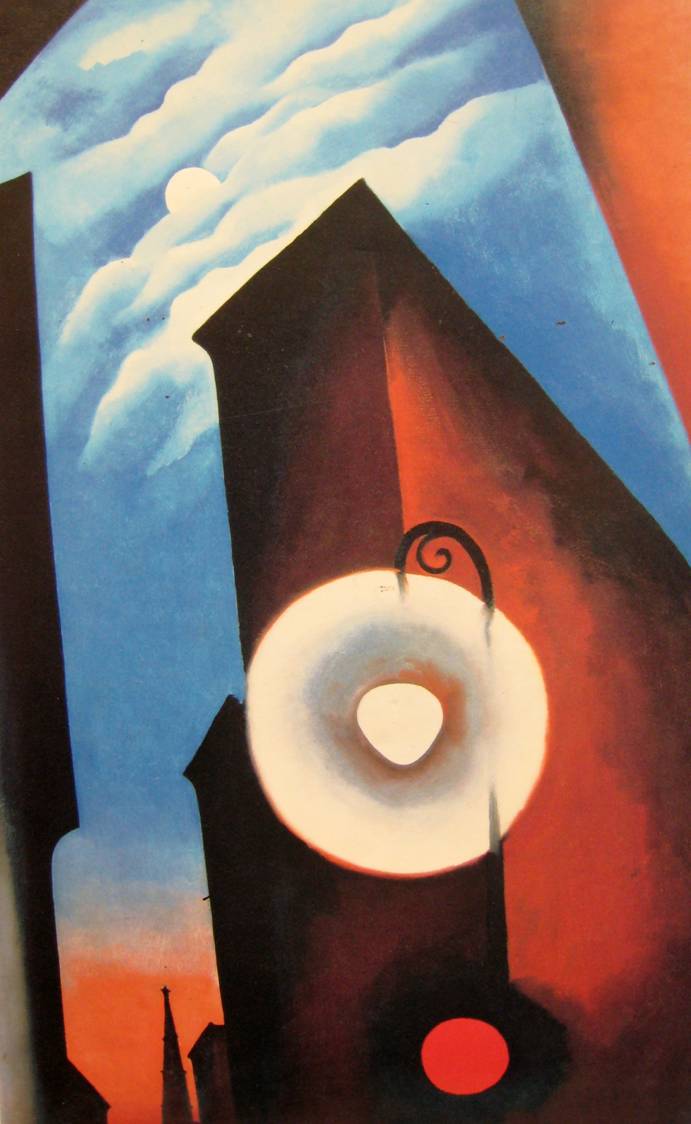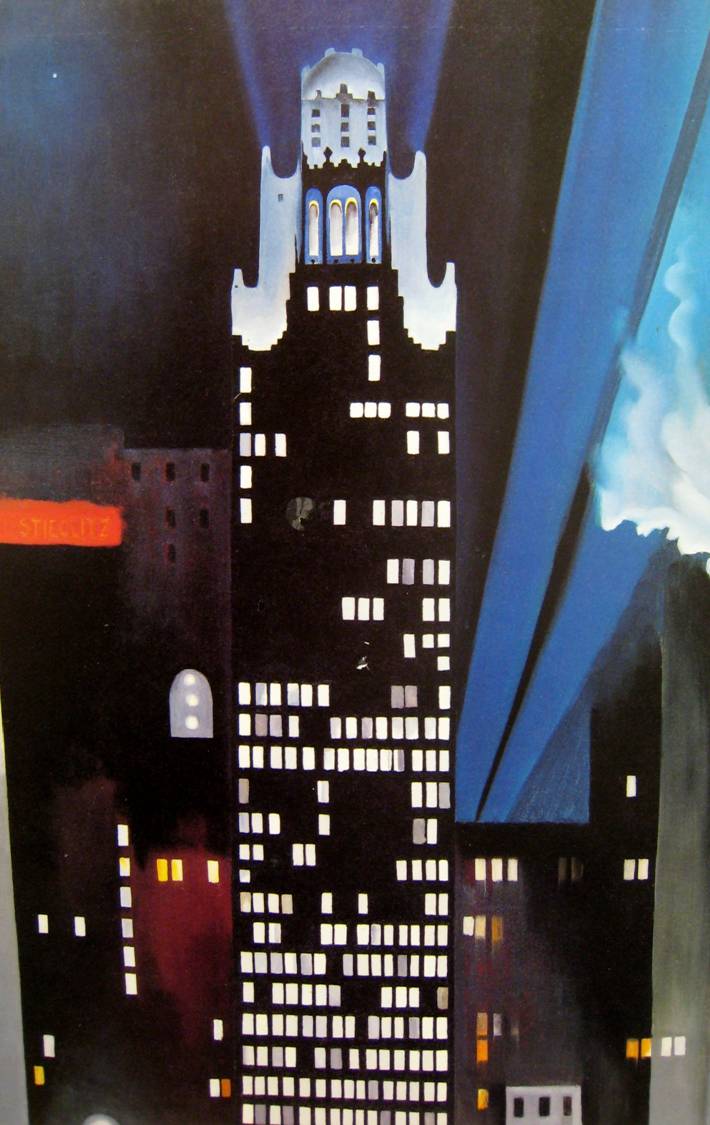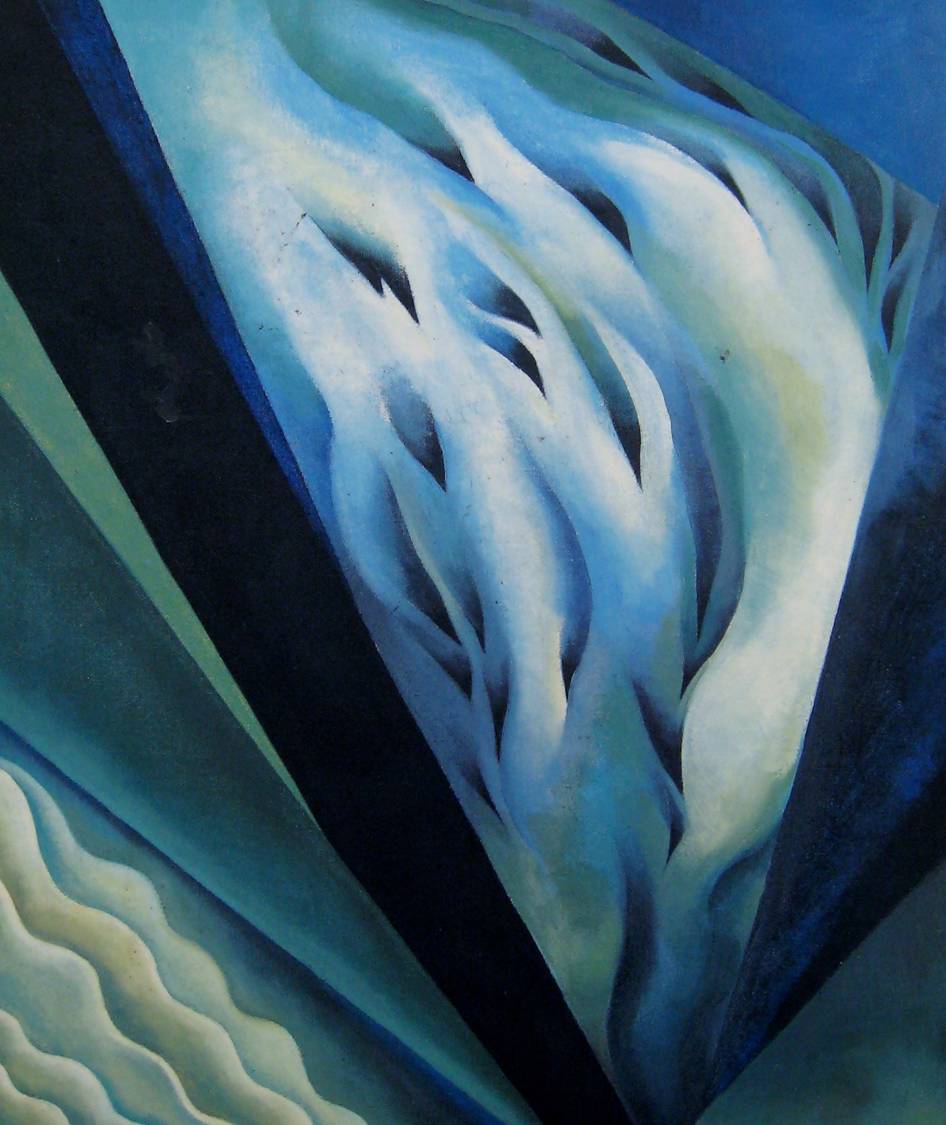1. Georgia O’Keeffe Photographic Portrait By Alfred Steiglitz
2. Red Canna
3. Morning Glory with Black
4. Oriental Poppies
5. New York Moon
6. Radiator Building—Night New York
7. Green & Blue Music
8. Pink & Blue Music
9. Gray Line with Black, Blue & Yellow
10. Open & Closed Clam Shell
11. Red Hills and Bones
This packet is filled with COLOR, so a color wheel project would naturally work (grades 1-5). The abstract paintings suggest a project using WARM or COOL COLOR (second grade), COMPLIMENTARY COLOR (grades 4 & 5), mixing SECONDARY COLOR (first grade), mixing INTERMEDIATE COLOR (grades 3 & 4), or COLOR VALUES (Tints and Shades—grades 3-5).
There are many examples of curved LINE to point out in Georgia’s flower paintings, abstract paintings, Open and Closed Clamshell and Red Hills and Bones paintings. New York with Moon and Radiator Building-Night, New York illustrate many examples of straight and diagonal LINE. These two paintings are also good examples to use in a discussion of SHAPE (geometric). Discuss and define organic SHAPE (Red Canna, Morning Glory with Black, Oriental Poppies, Open and Closed Clamshell, Red Hills and Bones) and abstract SHAPE (Gray Line with Black, blue and Yellow, Pink and Blue Music).
A SPACE/PERSPECTIVE discussion—FOREGROUND, MIDDLE GROUND AND BACKGROUND—could accompany the Landscape of Red Hills and Bones. Be sure to define WHAT a Landscape is for younger kids. Ask older kids to define a Landscape first, and define it for them only if the answers indicate they don’t know. Discuss and point out examples of the spatial devices of OVERLAP and RELATIVE SIZE in this painting (second grade). The bones in the foreground are an excellent example of RELATIVE SIZE. Second graders could create a Landscape using these two devices
(*Grade level suggestions are based on Washington State Essential Academic Learning Requirements).
Be sure ALL 11 pictures are returned to the Packet Carrier after your Presentation.
Georgia O’Keeffe
Georgia O’Keeffe was born November 15, 1887, on a farm in Sun Prairie Wisconsin. She was the second of seven O’Keeffe children. Even as a child, Georgia wanted to be an artist. She spent hours each day drawing and painting. Her mother gave her books to study drawing and arranged painting lessons for her and her sisters every Saturday. Georgia especially enjoyed watercolor painting but became tired of her lessons because her teachers were having her copy pictures. She preferred to do her own original art experiments at home.
When Georgia was a young girl, her mother Ida never imagined it would be possible for her daughter to become a painter of fine works of art that would hang in museums throughout the world. In the late 1800’s, women’s art—baskets, quilts, pottery, decorative drawings and paintings—was not considered important enough to be exhibited in art museums. Ida wanted all of her daughters to learn to paint decorative items, which she thought would help them become “proper ladies” of society. She hoped her daughters might even become art teachers someday. When Georgia was ten years old, she and her sisters took painting lessons. By the time she was thirteen, Georgia knew in her heart that she wanted to be an artist.
Georgia went to art school, in 1905, at the Art Institute of Chicago. Since the turn of the century, female students had finally been admitted to most American art schools. Even so, in 1905, Ida O’Keeffe was considered ahead of her time for sending her daughter to a worldly art school. During the first day of anatomy class at the Art Institute, students drew pictures of a male model that wore only a loincloth (like an Indian). Georgia was embarrassed but soon got used to it. Most people during Georgia’s days thought this type of required art class was not proper for a young woman to attend. This resulted in very few women being enrolled at the art school.
Georgia wanted to paint what was important to her but her teachers felt she should study painting by imitating the works of other artists. Georgia’s teachers wanted her to paint what they saw, instead of what she saw. Her vision of art was original and imaginative. She didn’t like to draw or paint what others had created. When she discovered that some of her art resembled that of other artists, Georgia destroyed it.
After she finished school, O’Keeffe became an art teacher in Texas. She enjoyed the landscapes of Texas very much, and the plains, ocean and sunsets there later played an important part in her painting.
In 1915, Georgia went to South Carolina to teach. While she was there, Georgia sent several of her drawings and watercolors to her old school friend for comments. Her friend showed O’Keefe’s unusual watercolors to Alfred Steiglitz, a New York Art Gallery owner. He was a powerful and well-known figure in the New York City art world and his Art Gallery was called “291”. Steiglitz, who was also a photographer, immediately recognized Georgia’s rare abilities. (See Packet 1. The Art of Photography)
Soon Georgia was living and painting in New York City. A very close relationship between Steiglitz and O’Keefe began. As artists, they supported each other’s work and drew inspiration from each other. In 1924, Steiglitz and O’Keefe were married. Steiglitz took many beautiful and unusual photographs of Georgia during their long relationship. (Display photograph of Georgia O’Keeffe.) Some photographs were so unusual that they show us only her hands, or neck, or back. Alfred’s photographs of Georgia are very simple and stark, much like Georgia’s paintings.
Almost from her very first exhibition, Georgia had success as a painter. During the period from 1916-1919, her work was very abstract (EXPRESSIONISM). As her own personal vision of art became more defined, her paintings turn more toward reality (REALISM). Georgia portrayed the world simply as she saw it and her vision had many unusual perspectives.
Red Canna
Oil on Canvas, 36” x 30”
(1924)
This original painting is MUCH larger than the size of this print. Georgia created a close-up view of this tropical flower. Now it looks as if the flower is exploding off the edges of the canvas. Warm and shiny colors radiate from the center. The ruffled petal shapes create a RHYTHM that ripples and flows. What type of COLOR did Georgia use to paint this flower? Warm color
Morning Glory with Black
Oil on Canvas, 36” x 40”
Notice how Georgia has shown us the center of the flower and the rest of the flower moves all the way off the edge of the canvas. What do you think the black in this painting is? (Where the petal edge, that is closest to the viewer, ends)
Throughout her lifetime, Georgia painted hundreds of flower images of every color, shape and variety. Cleverly, she increased the scale, or size, of her flower paintings to fill very large canvases and appear much larger than the real flowers. When people asked her why she made her flowers so large, Georgia asked them shy they never wondered why she made her rivers so small.
Oriental Poppies
Oil on Canvas, 30” x 40”
Poppies were one of Georgia’s favorite subjects. This painting shows two blossoms filling the canvas in SYMMETRICAL BALANCE. To achieve symmetry, Georgia positioned the flowers evenly so that if the canvas were folded in half, each side would appear roughly the same. She used warm colors for the petals of the poppies. The centers of the flowers are velvety dark shades, which contrast against the light tints of the edges of the petals. This draws our eyes deep into the center of these flowers.
Project Idea
- (K-2) On a small piece of white construction paper, draw a flower that covers the entire page, from edge to edge. Draw lightly with a pencil (in case kids misunderstand and draw their flower too small, they will be able to erase). Volunteers should be sure to walk around the room and be sure they understand what you want them to draw. A simple line drawing example would help kids understand the assignment better. Kids should color their drawing with crayons, using either warm or cool colors. Be sure to review, which colors are warm and which colors are cool before kids begin coloring.
- (3-5) Older kids can draw their flower on larger size white construction paper. To help kids draw large, suggest that a portion of the flower should touch each of the four edges of the paper. Paint the flowers with watercolors using warm or cool colors. You might have them create two flower pictures—one with warm and one with cool color.
New York with Moon
Oil on Canvas, 48” x 30”
(1925)
Georgia has painted some tall buildings in New York City, from a very unusual perspective. This is a Cityscape. The painting begins at a level that is higher than the street. There are many geometric SHAPES in this picture. How many circles can you find? Triangles? Can you find any rectangles or squares?
What is the first thing your eyes see when you look at this picture? How do your eyes move through the picture? The center of interest is the street light with its circling glow of light. Then our eyes travel up the building to the moon and clouds in the sky. Eventually, our eyes travel back down to the red dot at the bottom and the church steeple.
What do you think the red dot at the bottom of the picture is? A light?
Radiator Building—Night, New York
Oil on Canvas, 18” x 30”
(1927)
This is another interesting Cityscape.
What are all of the small rectangles in this picture? Small, lighted windows
Notice how Georgia painted the windows different shades of white, gray, yellow, orange and red. There are even some black rectangles of windows. Most of the windows, with their light turned off, blend into the black of the buildings but in some spots the buildings seem to reflect light and are not totally black.
Can you find a larger, arched window in the picture?
Can you see the city spotlights? The drifting smoke (or steam)?
Do you see the neon sign that says “Steiglitz”? (It is red)
What is “Steiglitz”? The last name of Georgia’s photographer husband, who had an Art Gallery in New York City, called “291”.
Point out the unusual SHAPE at the top of the center building. Can you see the light reflecting from this shape?
Can you see a star in this picture? It is a small white dot in the top left corner of the picture.
What do you think the small, white circles at the bottom of the picture are? Glowing street lights
Project Ideas
- Create a cityscape at night by cutting black or gray rectangles, squares and triangles and gluing them across a sheet of gray or blue paper, turned horizontally. Cut some small yellow, gray or white rectangles for windows. Cut a moon from white or yellow paper. You might also add stars (dots) with a white or yellow gel pen. Remember, cities have a lot of light so it’s hard to see many stars.
- Draw a cityscape like the example page Skyline Pictures.
Skyline Cityscape Pictures
Without lifting your pencil from the paper, draw a line like this:
Add windows, towers, roofs, smokestacks, or domes.
You can create various patterns with the different shaped windows of the buildings.
You can even create a building with arched or stained glass windows.
You can change the time of day it is by the color you choose for the background.
You can add clouds for a daytime sky or stars for a nighttime sky.
Now you can you draw a city skyline of your own!
Gray Line with Black, Blue and Yellow
Suggested Dialogue
What COLORS do you see in this very colorful watercolor painting?
Which COLORS are not included in the title of the painting? Orange, lavender, green and pink
What colors do you need to mix to create these colors? Orange = red + yellow,
Lavender = blue + red + white, Green = yellow + blue, Pink = red + white
The Primary Colors are red, yellow and blue. These hues are true colors. This means that no other colors can be mixed to produce the Primary Colors.
Which colors are the Secondary Colors? Orange, green, violet
Which colors are called WARM COLORS? Red, yellow and orange
Which colors are called COOL COLORS? Blue, green and violet
Where is the Gray Line? In the very center of the picture, where some black has been added. All of the colors that meet in the center are shaded.
Does this painting have ASYMMETRICAL or SYMMETRICAL BALANCE? Symmetrical Balance because it is roughly the same on each side, if you divide it in half down the center.
Project Idea
Display this picture at the front of the room for the kids to see and follow as an example while they paint this project. (5th grade)
This will help kids see the direction they are going to paint in and how to paint their own lines close together.
Tape a sheet of white construction paper, on all four sides, to the desk vertically. Wet the sheet completely, by spraying with a water bottle. Let this soak in and spray a second time to wet any dry areas if you need to. Thin primary colors of tempera paint and use 1” or 2” sponge brushes.
Beginning with the lightest color, yellow, wet the sponge brush, dip it into the thinned paint and create a few slightly curving lines, vertically, on either side of the center of the paper. Leave a lot of unpainted areas here as you paint about 4 yellow lines this way. Both the paper and the sponge need to be very wet so that the color will run or spread across the paper.
Rinse the sponge thoroughly and be sure ALL the yellow paint is gone. Now, follow the same procedure with 2 lines of red, moving out on either side from the center. Rinse the sponge brush thoroughly. Repeat procedure with the blue color. Add more yellow lines now. Be sure that there are more lines of yellow so that the red and blue can blend with the yellow. Fill in any empty spaces with more wet color. When the entire paper is filled with color, take a small paintbrush and black watercolor to paint a gray line near the center of the picture. Be sure that the black does not overpower the colors and that the paper is still wet. If you painted the black line too darkly, spray with water to lighten it.
Music—Pink and Blue I
Oil on Canvas, 35” x 29”
Does anyone have a guess what this picture may be? Do not tell the class the name of the painting until after they have a chance to guess a few times. Point out that the picture is ABSTRACT because it doesn’t look like anything real.
What does music look like? Point out that we cannot SEE music, but only hear it. Music is not concrete.
This abstract painting shows a MOOD or a feeling. What you see here is the way that music Georgia was listening to made her feel as she painted.
Pink and blue are the colors the music reminded Georgia of.
What type of music do you think she was listening to? Do you think it could have been a baby’s lullaby?
Blue and Green Music
(Oil on canvas 23” x 19”)
When Georgia was painting this picture, the music made her mind see the colors blue and green.
What type of music do you think Georgia was listening to while she painted this picture?
There are many LINES in this picture. Notice how some lines are very light and some are very dark. These are the lines that the sound of the music she was listening to inspired her to paint.
Can you see any LINES that remind you of MOVEMENT? The wavy lines in the bottom left corner are like rippling waves. The curving lines and shapes in the center appear to be moving or blowing towards the left of the picture.
Project Ideas
- Bring in a type of instrumental music—symphonic, piano, organ, brass, string, classical, marching, waltzing, swing, jazz, lullaby, etc. Before playing the music, have the class get their watercolors and painting supplies ready. Tell the class not to start painting until the music begins. Explain that when the music starts they need to listen to it closely. After they have listened for a few seconds or so, they need to choose colors that the music reminds them of. They ARE NOT supposed to paint a PICTURE with the paint! They should only paint lines—curved, wavy angled, crooked, rounded, squared, pointy, flat, skinny, wide, narrow at one end and fat at the other—any type of line that seems to match the music they hear. Explain that the painting MUST stop when the music ends so they WILL NOT have time to think about WHAT they are painting, only HOW. Make it clear that they are to listen to the music and let it inspire the way they paint. This is a painting with feelings, a MOOD. It should show the feelings that the music gave to them as they listened to it.
- Bring in FOUR DIFFERENT types of instrumental music—soft, loud, calming, exciting. Give everyone a large sheet of white construction paper. Have them fold it twice, to divide the paper into four equal squares. Instruct everyone to take out their crayons, markers or colored pencils. (Crayons and markers work best for this project.) Explain that you have brought four very different types of music with you. Each time you play one of the types of music, they will need to fill in one of the squares with the colors, lines and shapes that the music makes them think of or feel. Each type of music should remind them of different colors because the music sounds are each very different. Remind the class that they will only color LINES and SHAPES, NOT objects. The pictures are supposed to be very abstract and not resemble anything real. They should only be coloring the way the music makes them feel as they listen to it. Write the titles of each of the four works of art on the back of each picture. The titles should include the colors and the word MUSIC. Consider offering a small prize for the most original title.
Red Hills and Bones
What type of painting is this? A Landscape, which is a scene of the outdoors.
This painting was inspired by the desert hills of New Mexico, where Georgia O’Keeffe owned a ranch, near Santa Fe.
Is this a REALISTIC or EXPRESSIONISTIC Landscape? Georgia has simplified and exaggerated so many aspects of this picture that it is somewhat ABSTRACT. She meant to create a feeling of the landscape that she loved.
Does it look like a desert? Can you tell if it is hot?
What is the white shape pictured in the foreground of this landscape? Bones
Why do you think Georgia included the bones? Explain that she collected objects from the desert to show “all the life that has been lived in a place”.
What relationship does she suggest between the hills and bones? Which are older—the hills or the bones? Which is more important? What takes up the most space in the painting—the hills or the bones? Why do you think she included flowers?
What COLORS did the artist use for the hills? Are they WARM or COOL?
Notice the subtle sunlight as the colors change from pink to orange to purple. The whiteness of the bones is a stark contrast against the strong hills of the background and the fragile, wispy flowers.
Notice the SHAPE of the hills. Are they created with geometric shape? No, organic shape
Can you see how Georgia causes us to think about the connection between the hills and the bones? Are they alike or different? Peaceful or frightening?
Where do people fit into this view of nature?
Project Idea
Paint a desert landscape using warm colors.
Open and Closed Clam Shell
Oil on Canvas, 20” x 9”
(1926)
See if kids can tell what this is a picture of, before you tell them the title. O’Keeffe has focused so closely on the shells they have become almost ABSTRACT.
Project Ideas
- Bring in a real clamshell to paint or draw.
- Bring in a different type of large shell for the kids to paint or draw from a close focus.
- Create a Still Life arrangement with various and assorted shells and driftwood. Give kids colored chalk or oil pastels to create a Still Life picture.

